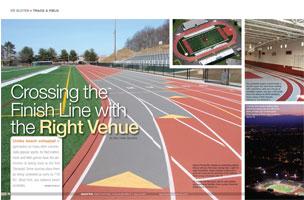
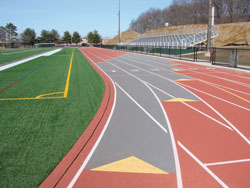 |
| Photo courtesy of American Athletic Courts, Vincentown, NJ |
Unlike beach volleyball or gymnastics (or many other commercially popular sports, for that matter), track and field games have the distinction of dating back to the first Olympiad. Some sources place them as being contested as early as 776 BC. (Beat that, you balance beam acrobats).
Track and field games continue to enjoy popularity today. The sports participation summary of the National Federation of State High School Associations (NFHS, the governing body for high school athletics) rates outdoor track and field as the most popular sport for girls during the 2008-2009 school year,with over 450,000 participants. For boys, it is the second most popular (football is the first) with over 550,000 participants. In 2007, the National Collegiate Athletic Association, or NCAA, noted that there were more female student athletes in track and field than any other women's sport since 1990; for men's sports, track and field had one of the highest participation levels, after football.
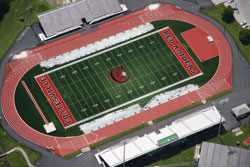 |
| Photo courtesy of ELA Sport, Lititz, PA |
With statistics like that, it's no wonder that track and field competitions, skill clinics, sports camps and more are proliferating. And if you're in charge of such an event, your goal is the same as that of your athletes: to cross the finish line a winner. Just choose the right venue, and you will.
Track and Field 101
To understand track and field facilities, it is necessary to understand track and field events. These are varied, with separate divisions in which male and female athletes compete for speed (running, sprinting and walking events in various distances), distance (throwing events: the discus, hammer, shot put and javelin, and certain jumping events: the long jump and triple jump) and height (high jump and pole vault). Some racing events may include hurdles, or may be conducted in a relay format. There are also combination events that involve a single athlete: pentathlon has five specific events in various jumping, throwing and running categories; heptathlon has seven, and decathlon has 10.
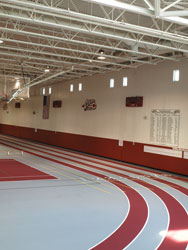 |
| Photo courtesy of Kiefer Specialty Flooring, Inc. of Lindenhurst, IL |
Track events are generally staged on a 400-meter track that is built in the shape of an oval. Many tracks have a sports field in the center, such as for football or soccer. On others, the infield is used for field events, such as shot put, discus, etc.
In order to accommodate different size athletic fields, the track may be configured slightly differently. Non-equal quadrant tracks and double bend tracks are the two most popular configurations today. A third type of track, the equal quadrant track, once common, is now rarely built in favor of the other two designs.
On the Surface
Early track facilities were made of fired clay, expanded shale or cinders. While they were low-impact, they turned into a mess on rainy days. Today's tracks are largely known as 'all-weather' facilities because they are safe to use immediately after a rain.
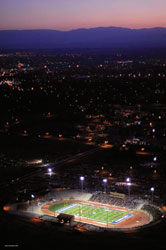 |
| Photo courtesy of Renner Sports Surfaces, Denver, CO. |
Tracks are built on an asphalt base, and may be permeable (or porous), meaning that water percolates down through them and is handled by a subsurface drainage system; or they may be impermeable (or non-porous) meaning that water runs off them because of slope and gravity, and flows to a surface drain. Surfacing systems (the springy rubbery surface of the track that the runner's shoes will touch) are either latex or polyurethane (although there is a great deal of variety within those two categories) or pre-manufactured rubber.
Examine the surface of the track on each facility you are considering. Look for a smooth, well-maintained surface free of worn or bare spots, cracks or other flaws, such as deep puddles of water that stand on the track.
"Not all surfaces are created equal, and some surfaces are better suited for competition based on higher levels of energy return and shock absorption," says Robert Cohen of Sport Surfaces Distributing, Inc. in Albuquerque, New Mexico. "In addition, it is important to know that as tracks age, they can become worn. A worn track will not perform as it should, and can contribute to injuries."
Who's in charge?
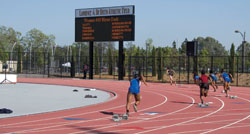 |
| Photo courtesy of the Beals Alliance, Sacramento, CA |
The first question to ask when choosing a track and field facility should be whether this is a competitive event. If it is, find out whether the facility you want is in compliance with the rules and regulations set forth by the governing body for the level of competition.
Each governing body has its own rules governing such things as the color of markings, track lane width, slope, curb dimensions and more. (A list of governing bodies and other informational organizations has been included with this article). Make sure the most up-to-date rules are being followed. (Note: Even for a sports camp or skills clinic, it is helpful for athletes to use facilities that are as close to the appropriate competition level as possible.)
Is it certified?
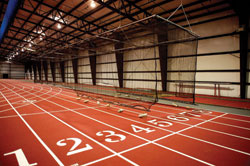 |
| Photo courtesy of Kiefer Specialty Flooring, Inc., Lindenhurst, IL |
If this a competition at which records may be set, a planner should find out whether the facility is certified, which is to say, professionally measured and recorded as being in compliance with the standards of the applicable governing body.Five different levels of track certification now exist-the highest (Class 1 and Class 2) are recognized by the International Amateur Athletics Federation, or IAAF, the international governing body. Class 3 and Class 4 are appropriate for college and high school facilities, and are recognized by the NCAA and NFHS. Class 5 is for practice tracks, as well as middle school and small high school meet facilities. The track owner should have documentation regarding any certifications that are in place for a particular facility. It is the responsibility of the event planner to pick out the most appropriate venue based on the needs of the athletes and the level of competition.
Outstanding in Your Field
Today's athletic fields may be either natural grass or synthetic turf; each has its advantages and disadvantages. However, in cases where throwing events are being held, the guidelines of the UEFA (the European governing body for soccer) state that shot put and discus can be held on artificial turf without damaging it, but that hammer and javelin should be held on natural grass.
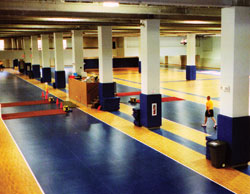 |
| Photo courtesy of Moose Sports Surfaces, Chicago, IL |
In all cases, look for a field that is well-maintained and free of any debris. Markings should be clear and easy to read, and infield equipment (including all field event areas) should be kept in good repair. Sand from sand pits should not be on the field or track.
Getting Down to Business
Having found a facility that fulfills all the technical requirements, it is time to turn your attention to other aspects. Ron Nemeth, a former athletic director and meet official, says planners should make sure the area is properly laid out.
"Entrance and exit gates to the event areas for the competitors should be located for quick access without hindering start and finish lines, since these areas must be clear for officials to perform their duties," says Nemeth. "Equally important are the entrance and exit gates for the general public.They need to be located for easy access to seating, concessions, parking, restrooms, etc. You do not want the general public walking alongside the track or other events in order to get to their seats."
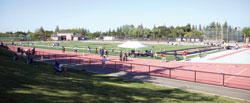 |
| Photo courtesy of the Beals Alliance, Sacramento, CA |
Track and field sports are popular, and you can count on family, friends, fans and even college scouts and media officials being present at various times, he adds.
"Seating is so important. The more seating available for good spectator viewing, the better. If throwing events are located away from the main viewing area, use some portable seating in these areas. Also, alternative seating can be used. Should your facility have banks or hills where spectators can easily see the action, by all means use them."
Joe Mauck of Schwab-Eaton, P.A. in Manhattan, Kansas recommends additional amenities including a scoreboard and a P.A. system. A press box, adequate parking, restrooms, lockers, showers and a first aid tent or office will all be essential. Lighting can extend the day and allow for events to continue past dark. Officials should understand the sport and the level of competition; a local athletic association can help locate referees and others.
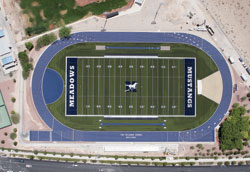 |
| Photo courtesy of General Acrylics, Inc., Phoenix, AZ |
Something all experts agree on is the necessity of a good facility staff. Events will not run themselves, after all.
"When an administrator can provide highly qualified, good natured, efficient, respected personnel to run the meet from the very top, meaning the meet manager to that youngster running a heat ticket from the start line to the finish line judge, that is what makes coaches to want to go to that particular facility," says Nemeth.
A good facility, good planning and good people-sounds like a first-place finish.

